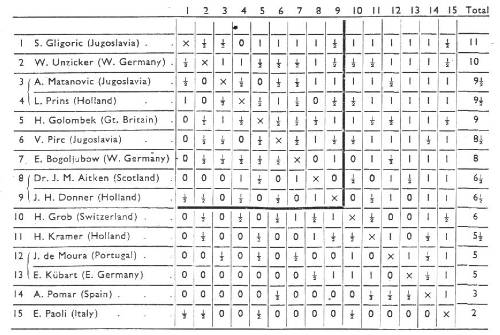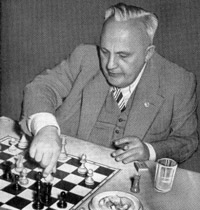
|
|
|
Bad Pyrmont 1951
Dr James M. Aitken was Scotland's representative at this Zonal, held at Bad Pyrmont in Germany from April 27 to May 16. Fifteen rounds were played, although there could have been more if all the countries expected to send players had obliged. Missing were O'Kelly from Belgium and Rossolimo of France, and there were no representatives from Greece, Ireland and Luxembourg.
Dr Aitken had won his first Scottish Championship in 1935, and would go on to win another nine times. He had played first board for Scotland at the Stockholm 1937 Olympiad, which gave him a taste of what it was like to face strong international opponents. He also played in the Olympiads at Munich 1958, Tel Aviv 1964 and Skopje 1972.
Aitken also played in the Zonal tournaments at Munich 1954 and Enschede 1963. Other international tournaments in which he competed were Bournemouth 1939, Hastings 1945/46 and 1946/47 and Southsea 1949. He also represented Great Britain in the radio match against the Soviet Union in 1946, and in the over-the-board meeting between the two countries in 1947. A few months after this Zonal, in September, Aitken also played in the Britain v Yugoslavia match. He also participated in a number of British championships.

Aitken had several good wins, the most inpressive being that against the veteran Bogoljubow.
Bogoljubow - Aitken [C50]
Bad Pyrmont (9) 1951Notes by Dr Aitken in the British Chess Magazine.
1.e4 e5 2.Nf3 Nc6 3.Bc4 Be7 A defence I have adopted very infrequently, though, as it happens, always with success. My purpose here was to avoid the lively lines possible after 3...Bc5 or 3...Nf6 - these I considered might prove most congenial to my present opponent. 4.d4 d6 5.d5 Nb8 6.Bd3 Nf6 7.c4 White's last few moves are the most orthodox continuation. Black now has to to determine his general plan for the game. The line I chose is possibly not the best as Black cannot keep the Queen's side blocked. Alternatives are to play 7...Nbd7, 8...Nf8, 9...h6, 10...g5, and ...Ng6 or to play (after 7...0-0) 8...Ne8 for an immediate 9...f5. 7...0-0 8.Nc3 Na6 9.h3 Nc5 10.Bc2 a5 11.Be3 b6 12.0-0 Ne8 13.Kh2 This came as a surprise to me. I expected 13.g4, when the game would continue on closed Lopez lines; White has the initiative but Black should always have a defence. Bogoljubow apparently considered that by allowing me some scope on the King's side he wuld succeed more easily in breaking through on the Queen's side. 13...f5 14.exf5 Bxf5 15.Bxf5 Rxf5 16.a3 Rf8 17.b4 It was much better to prepare this move by 17.Qc2 and so prevent the entry of the Black Knight at d3 and f4. The best reply is 17...g6 and if 18.b4 Nd7, not opening the Queen's side yet. 17...axb4 18.axb4 Rxa1 19.Qxa1 Nd3 20.Qb1 Nf4 21.Qb3 Kh8 22.Ne4 h6 My last two moves were necessary prophylactics against (1) c5, and (2) Ng5 en route to e6, when the Black Queen moves. 23.Ra1 Qc8 Threatening ...Nxh3. 24.Nfd2 g5 25.f3 Ng7 26.Ra7 A Most plausible mistake-in fact, not till later did I realise it was a mistake. 26.g4 is correct, when Black has a difficult game. If 26...Qb7 27.b5! Ra8 28.Ra4, when the prospects of passive defence appear so uninviting that the best chance may be 28...Rxa4 29.Qxa4 Nxd5 30.cxd5 Qxd5, when the material sacrificed may be sufficiently compensated by White's poor pawn position and exposed King. 26...Nf5 27.g4 [If 27.Bf2 Black can play (among other possible lines) 27...Qb8 28.Qa3 If the Rook retreats b5. 28...Nd3 29.b5 Nxf2 30.Nxf2 Nd4 with good counter-play.] 27...Qb8! A most important intermediate move, the full point of which appears on move 29. 28.Ra2 Nxe3 29.Qxe3 b5! This sally on the Queen's side wins the game as White can hardly save a pawn and his position suddenly appears as full of weaknesses. If 30.Qb3 Qb7 31.Nc3 Nd3 (threat Nc1 or in somee lines Ne1) 32.Ra1 Qb6 with a winning attack. 30.c5 Nxd5 31.Qb3 Qb7 32.Rc2 Nf4 33.Nf1 Qd5 Forcing off the Queens is the safest way to win. White can hardly avoid the exchange in view of the threats of invasion of his first three ranks by the Black Queen and Rook. 34.Rb2 Qxb3 34...Ra8 would have decided the issue more quickly. 35.Rxb3 Ra8 36.Rb2 d5 37.Nc3 c6 Again the surest. 37...Ra3 38.Nxb5 Rxf3 39.Ng3 should win but is rather more chancy. 38.Ra2 Rxa2+ 39.Nxa2 Nd3 40.Nd2 Bd8 41.Nb3 Kg7 42.Kg2 42.Na5 makes no essential difference to the game continuation. 42...Kf7 43.Na5 The only course to try and it must be played before the Black King gets to d7. My reply had been prepared by my 40th move. 43...Nxb4 44.Nxb4 I expected the trickier 44.Nb7 Nxa2 45.Nxd8+ Ke8! 46.Nxc6 b4 47.Nxe5 b3 48.Nd3 (Or 48.c6 Kd8 49.Nd3 Nb4 50.Nb2 Nxc6 followed by ...Na5 and ...Nc4.) 48...Nc1 49.Nb2 Ne2 and White has no effective move with either of his pieces. 44...Bxa5 45.Nxc6 Bc7 46.Nb4 Ke6 47.Kf1 Ba5 48.Nc6 Bc3 49.Ke2 This allows Black to force a winning King and pawn ending but 49.Nd8+ Kd7 50.Nf7 Kc6 51.Nxh6 Kxc5 is clearly equally hopeless. The rest of the play is forced. 49...Kd7 50.Na7 b4 51.Kd3 Bd4 52.c6+ Kc7 53.Nb5+ Kxc6 54.Nxd4+ exd4 55.f4 gxf4 56.h4 Kd6 57.h5 Ke5 White resigns.
Aitken - Prins [C70]
Bad Pyrmont (12) 19511.e4 e5 2.Nf3 Nc6 3.Bb5 a6 4.Ba4 Bc5 5.0-0 b5 6.Bb3 d6 7.c3 Qf6 8.d4 exd4 9.Bg5 Qg6 10.Bd5 Bd7 11.cxd4 f6 12.Be3 0-0-0 13.dxc5 dxc5 14.Ne1 f5 15.Qc2 f4 16.Bxf4 Nd4 17.Qd3 Nf6 18.Nc3 c6 19.Bb3 Bg4 20.Qe3 b4 21.Bc4 bxc3 22.Bxa6+ Kd7 23.bxc3 Rhe8 24.f3 Bxf3 25.Nxf3 Nd5 26.Qd2 Qxe4 27.cxd4 Nxf4 28.Ne5+ Rxe5 29.dxe5+ Black resigns.
Aitken had an interesting situation in his round 4 endgame with Grob, which resulted in the dropping of a ½ point. Here is the position after White's 73rd move:
This position featured in an article entitled 'The Adventures of the Swiss Grob' in the Deutsche Schachblätter 1951, p 91/2. Four positions from Grob's games at this Zonal were featured, all of which showed the typical ups and downs of tournament play; wins turned into losses and losses turned into draws. This example is one of the latter.
Aitken continued 73...d2+. After the game, Grob exclaimed excitedly how he had used great forsesight in placing his King on c1 after Aitken gave check on move 71. "I know these positions!" 74. Kd1 Kd3?? And Aitken falls into the draw trap. The article (by Dr H. Staudte) commented that the "sideways" move 74...Kb5, aiming for the manoeuvre ...B-b6-a5 would have won easily. 75. Ra8! Rb2 76. Rb8! Ra2 77. Ra8 Rc2 78. Rd8+ Kc3 79. Rd3+! Drawn. For if 79...Kb2, then 80. Rxd2.
Sources:
BCM 1951, p 175 - crosstable; pp 247-9, game Bogoljubow-Aitken.Alan McGowan
Historian, Chess Scotland
